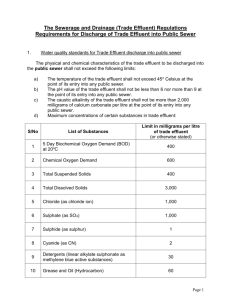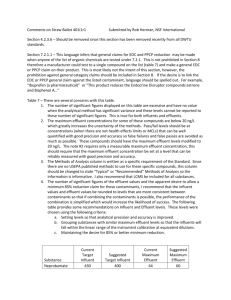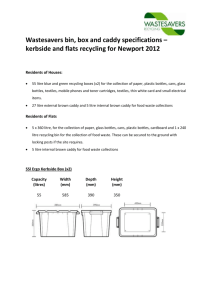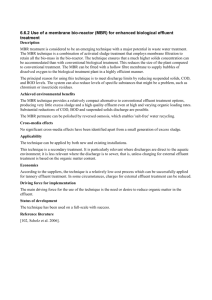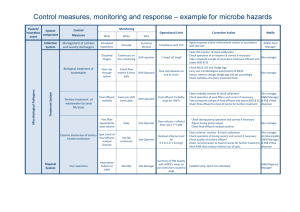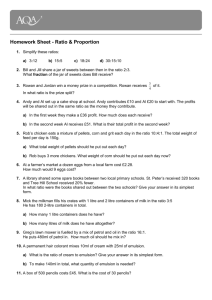Government Gazette No 9225, 18 May 1984. Regulation No
advertisement
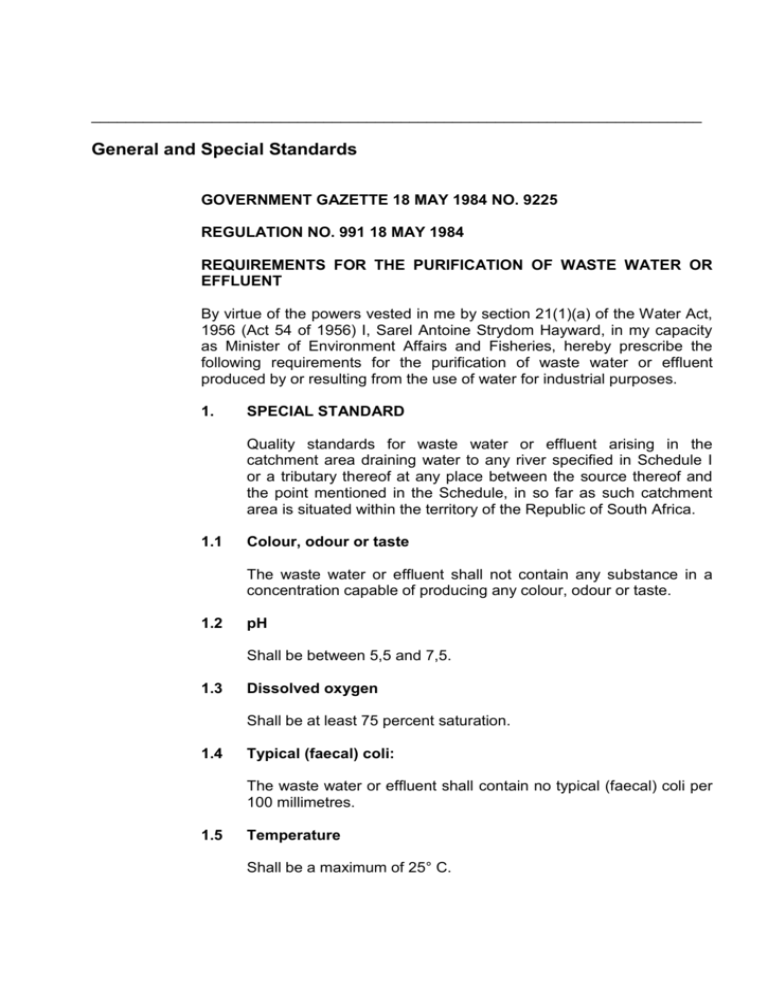
_______________________________________________________________________ General and Special Standards GOVERNMENT GAZETTE 18 MAY 1984 NO. 9225 REGULATION NO. 991 18 MAY 1984 REQUIREMENTS FOR THE PURIFICATION OF WASTE WATER OR EFFLUENT By virtue of the powers vested in me by section 21(1)(a) of the Water Act, 1956 (Act 54 of 1956) I, Sarel Antoine Strydom Hayward, in my capacity as Minister of Environment Affairs and Fisheries, hereby prescribe the following requirements for the purification of waste water or effluent produced by or resulting from the use of water for industrial purposes. 1. SPECIAL STANDARD Quality standards for waste water or effluent arising in the catchment area draining water to any river specified in Schedule I or a tributary thereof at any place between the source thereof and the point mentioned in the Schedule, in so far as such catchment area is situated within the territory of the Republic of South Africa. 1.1 Colour, odour or taste The waste water or effluent shall not contain any substance in a concentration capable of producing any colour, odour or taste. 1.2 pH Shall be between 5,5 and 7,5. 1.3 Dissolved oxygen Shall be at least 75 percent saturation. 1.4 Typical (faecal) coli: The waste water or effluent shall contain no typical (faecal) coli per 100 millimetres. 1.5 Temperature Shall be a maximum of 25° C. 1.6 Chemical oxygen demand Not to exceed 30 milligrams per litre after applying the chloride correction. 1.7 Oxygen absorbed: The oxygen absorbed from acid N/80 potassium permanganate in 4 hours at 27° C shall not exceed 5 milligrams per litre. 1.8 Conductivity 1.8.1 Not to be increased by more than 15 percent above that of the intake water. 1.8.2 The conductivity of any water, waste water or effluent seeping or draining from any area referred to in section 21(6) of the aforementioned Water Act shall not exceed 250 milli-Siemens per metre (determined at 25° C). 1.9 Suspended solids Not to exceed 10 milligrams per litre. 1.10 Sodium content Not to be increased by more than 50 milligrams per litre above that of the intake water. 1.11 Soap, oil and grease None. 1.12 Other constituents 1.12.1 Constituents Maximum concentration in milligrams per litre Residual chlorine (as CP) ...................................................... ..... Free and saline ammonia (as ...................................................... N) ..... Nitrates (as N) ...................................................... ..... Arsenic (as As) ...................................................... ..... Boron (as B) ...................................................... ..... Total chromium (as Cr) ...................................................... Nil 1,0 1,5 0,1 0,5 0,05 ..... ...................................................... ..... Phenolic compounds (as ...................................................... phenol) ..... Lead (as Pb) ...................................................... ..... Soluble ortho-phosphate (as ...................................................... P) ..... Iron (as Fe) ...................................................... ..... Manganese (as Mn) ...................................................... ..... Cyanides (as Cn) ...................................................... ..... Sulphides (as S) ...................................................... ..... Fluoride (as F) ...................................................... ..... Zinc (as Zn) ...................................................... ..... Cadmium (as Cd) ...................................................... ..... Mercury (as Hg) ...................................................... ..... Selenium (as Se) ...................................................... ..... Copper (as Cu) 0,02 0,01 0,1 1,0 0,3 0,1 0,5 0,05 1,0 0,3 0,05 0,02 0,05 1.12.2 The waste water or effluent shall contain no other constituents in concentrations which are poisonous or injurious to trout or other fish forms of aquatic life. 2. SPECIAL STANDARD FOR PHOSPHATE Waste water or effluent arising in the catchment area within which water is drained to any river specified in Schedule II or a tributary thereof at any place between the source thereof and the point mentioned in the schedule, in so far as such catchment area is situated within the territory of the Republic of South Africa shall not contain soluble ortho-phosphate (as P) in a higher concentration than 1,0 milligram per litre. 3. GENERAL STANDARD Quality standards for waste water or effluent arising in any area other than an area in which the SPECIAL STANDARD is applicable, as described in paragraph 1. 3.1 Colour, odour or taste: The waste water or effluent shall not contain any substance in a concentration capable of producing any colour, odour or taste. 3.2 pH Shall be between 5,5 and 9,5. 3.3 Dissolved oxygen Shall be at least 75 percent saturation. 3.4 Typical (faecal) coli The waste water or effluent shall not contain any typical (faecal) coli per 100 millilitres. 3.5 Temperature Shall be a maximum of 35° C. 3.6 Chemical oxygen demand Not to exceed 75 milligrams per litre after applying the chloride correction. 3.7 Oxygen absorbed: The oxygen absorbed from acid N/80 potassium permanganate in 4 hours at 27° C shall not exceed 10 milligrams per litre. 3.8 Conductivity 3.8.1 Not to be increased by more than 75 milli-Siemens per metre (determined at 25° C) above that of the intake water. 3.8.2 The conductivity of any water, waste water or effluent seeping or draining from any area referred to in section 21(6) of the aforementioned Water Act shall not exceed 250 milli-Siemens per metre (determined at 25° C). 3.9 Suspended solids Not to exceed 90 milligrams per litre. 3.10 Sodium content Not to be increased by more than 90 milligrams per litre above that of the intake water. 3.11 Soap, oil and grease Not to exceed 2,5 milligrams per litre. 3.12 Other constituents 3.12.1 Constituents Maximum concentration in milligrams per litre Residual chlorine (as C1) ...................................................... ..... Free and saline ammonia (as ...................................................... N) ..... Arsenic (as As) ...................................................... ..... Boron (as B) ...................................................... ..... Hexavalent chromium (as Cr) ...................................................... ..... Total chromium (as Cr) ...................................................... ..... Copper (as Cu) ...................................................... ..... Phenolic compounds (as ...................................................... phenol) ..... Lead (as Pb) ...................................................... ..... Soluble ortho-phosphate (as ...................................................... P) ..... Iron (as Fe) ...................................................... ..... Manganese (as Mn) ...................................................... ..... Cyanides (as Cn) ...................................................... ..... Sulphides (as S) ...................................................... ..... Fluoride (as F) ...................................................... ..... Zinc (as Zn) ...................................................... ..... Cadmium (as Cd) ...................................................... ..... Mercury (as Hg) ...................................................... ..... Selenium (as Se) ...................................................... ..... 0,1 1,0 0,1 0,5 0,05 0,05 0,02 0,01 0,1 1,0 0,3 0,1 0,5 0,05 1,0 0,3 0,05 0,02 0,05 3.12.2 The sum of the concentrations of the following metal shall not exceed 1 milligrams per litre: Cadmium (as Cd), chromium (as Cr), copper (as Cu), mercury (as Hg) and lead (as Pb). 3.12.3 The waste water or effluent shall contain no constituents in concentrations which are poisonous or injurious to humans, animals, fish other than trout, or other forms of aquatic life, or which are deleterious to agricultural use. 4. METHODS OF TESTING All tests shall be carried out in accordance with methods prescribed by and obtainable from the South African Bureau of Standards, referred to in the Standards Act, No. 30 of 1982, as listen in Schedule III. NOTE: (a) Further information and elucidation may be obtainable from the Director-General: Environment Affairs, Private Bag X313, Pretoria, 0001. (b) Government Notices R.553 of 5 April 1962, R.969 of 22 June 1962 and R.1567 of 1 August 1980 are hereby withdrawn.
